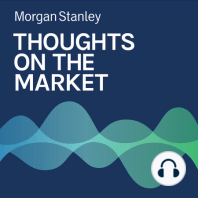4 min listen

Vishy Tirupattur: Tumult in the Banking Sector
Vishy Tirupattur: Tumult in the Banking Sector
ratings:
Length:
4 minutes
Released:
Apr 18, 2023
Format:
Podcast episode
Description
As the U.S. banking sector faces oncoming regulatory changes, how will the smaller banks react to these new requirements and what will the impact be on markets?----- Transcript -----Welcome to Thoughts on the Market. I am Vishy Tirupattur, Morgan Stanley's Chief Fixed Income Strategist. Along with my colleagues, bringing you a variety of perspectives, I'll be talking about the impact of potential regulatory changes on bank assets. It's Tuesday, April 18th at 11a.m in New York. In the wake of the tumult in the banking sector since early March, and the significant intervention by the authorities, it is likely that a regulatory response will follow, particularly focused on the regulation of regional banks. President Biden has already called on the federal banking agencies in consultation with the Treasury Department, to consider a set of reforms that will reduce the risk of future banking crises. A review led by Michael Barr, the Vice Chair for Supervision at the Federal Reserve Board, is set to be released by May 1st and will likely offer some indication as to where future bank regulation might be headed. In this context, it is worthwhile to examine potential changes to regional bank regulation, reflect on how banks would respond to such changes and consider their impact on markets. Across all banks, there are approximately 4.7 trillion of non-interest bearing deposits with the duration of about seven years. Banks will likely need to either review and re-justify or shorten such deposits. Our bank equity analysts expect two key regulatory changes TLAC, total loss absorbing capacity and LCR, liquidity coverage ratio, to be extended to smaller banks, about $100 billion in assets, though this process will likely not get fully implemented until 2027. From the perspective of rates markets, these changes make the case for steepening of the curve. Our rate strategists see bank demand for treasuries increasing relative to other assets with greater LCR requirements. Both shortening deposit duration and implementing LCR suggest that banks would favor shorter dated Treasuries over longer dated Treasuries. More longer term issuance due to TLAC, drives higher long term yields and fixed income, with support curve steepeners for Treasuries over the medium term. For agency mortgage backed securities, these changes will result in less demand from banks and consequently wider mortgage spreads. For munis, these changes would likely imply a lower footprint from banks with available for sale securities favored or held to maturity securities. For securitized credit markets, we see downside in demand ahead. Longer term outlook for securitized credit depends on the specifics of regulatory reform, but is likely to remain tepid for some time to come. The expansion of TLAC to smaller banks could intensify supply headwinds in the medium term. Our credit strategists believe that supply risks in bank credit are now skewed to the upside. The emphasis on funding diversity and shift away from deposits to wholesale funding, is likely to keep regional bank issuance elevated for longer. An important lesson from recent events in the banking sector, is that the risks to the asset banks hold, extend beyond credit risk into other risks, most notably interest rate risk. While interest rate and convexity risks are reflected in Comprehensive Capital Analysis Review, CCAR and Horizontal Liquidity Review, HLR test, arguably not having an interest rate component to risk weights enable banks, and regional banks in particular, to seek term premia to support their earnings. It is not our base case that this will change. However, it is possible that regulators would at least consider enacting some type of a charge for owning longer-duration securities. At a minimum, we expect the regulators could require all banks to flow marked-to-market hits from available-for-sale securities through their regulatory capital ratios, something that the big banks have been doing already. Ultimat
Released:
Apr 18, 2023
Format:
Podcast episode
Titles in the series (100)
Andrew Sheets: A Second (and Third) Opinion for Equity Markets by Thoughts on the Market